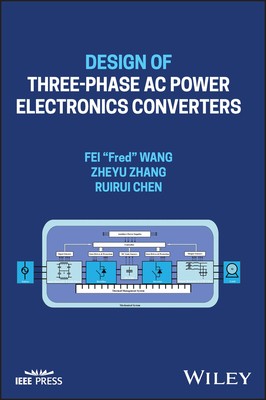
- We will send in 10–14 business days.
- Author: Fei Wang
- Publisher: Wiley-IEEE Press
- ISBN-10: 1119794234
- ISBN-13: 9781119794233
- Format: 17.8 x 25.4 x 3.7 cm, hardcover
- Language: English
- SAVE -10% with code: EXTRA
Reviews
Description
Comprehensive resource on design of power electronics converters for three-phase AC applications
Design of Three-phase AC Power Electronics Converters contains a systematic discussion of the three-phase AC converter design considering various converter electrical, thermal, and mechanical subsystems and functions. . Focusing on establishing converter components and subsystems models needed for the design, the text demonstrates example designs for these subsystems and for whole three-phase AC converters considering interactions among subsystems. The design methods apply to different applications and topologies.
The text consists of four parts. Part I is an introduction, which presents the basics of the three-phase AC converter, its design, and the goal and organization of the book. Part II focuses on characteristics and models important to the converter design for components commonly used in three-phase AC converters. Part III is on the design of subsystems, including passive rectifiers, inverters and active rectifiers, electromagnetic interference (EMI) filters, thermal management system, control and auxiliaries, mechanical system, and application considerations. Part IV is on design optimization, which presents methodology to achieve optimal design results for three-phase AC converters.
Specific sample topics covered in Design of Three-phase AC Power Electronics Converters include:
- Models and characteristics for devices most commonly used in three-phase converters, including conventional Si devices, and emerging SiC and GaN devices.
- Models and selection of various capacitors; characteristics and design of magnetics using different types of magnetic cores, with a focus on inductors
- Optimal three-phase AC converter design including design and selection of devices, AC line inductors, DC bus capacitors, EMI filters, heatsinks, and control. The design considers both steady state and transient conditions
- Load and source impact converter design, such as motors and grid condition impacts.
For researchers and graduate students in power electronics, along with practicing engineers working in the area of three-phase AC converters, Design of Three-phase AC Power Electronics Converters serves as an essential resource for the subject and may be used as a textbook or industry reference.
EXTRA 10 % discount with code: EXTRA
The promotion ends in 20d.23:01:33
The discount code is valid when purchasing from 10 €. Discounts do not stack.
- Author: Fei Wang
- Publisher: Wiley-IEEE Press
- ISBN-10: 1119794234
- ISBN-13: 9781119794233
- Format: 17.8 x 25.4 x 3.7 cm, hardcover
- Language: English English
Comprehensive resource on design of power electronics converters for three-phase AC applications
Design of Three-phase AC Power Electronics Converters contains a systematic discussion of the three-phase AC converter design considering various converter electrical, thermal, and mechanical subsystems and functions. . Focusing on establishing converter components and subsystems models needed for the design, the text demonstrates example designs for these subsystems and for whole three-phase AC converters considering interactions among subsystems. The design methods apply to different applications and topologies.
The text consists of four parts. Part I is an introduction, which presents the basics of the three-phase AC converter, its design, and the goal and organization of the book. Part II focuses on characteristics and models important to the converter design for components commonly used in three-phase AC converters. Part III is on the design of subsystems, including passive rectifiers, inverters and active rectifiers, electromagnetic interference (EMI) filters, thermal management system, control and auxiliaries, mechanical system, and application considerations. Part IV is on design optimization, which presents methodology to achieve optimal design results for three-phase AC converters.
Specific sample topics covered in Design of Three-phase AC Power Electronics Converters include:
- Models and characteristics for devices most commonly used in three-phase converters, including conventional Si devices, and emerging SiC and GaN devices.
- Models and selection of various capacitors; characteristics and design of magnetics using different types of magnetic cores, with a focus on inductors
- Optimal three-phase AC converter design including design and selection of devices, AC line inductors, DC bus capacitors, EMI filters, heatsinks, and control. The design considers both steady state and transient conditions
- Load and source impact converter design, such as motors and grid condition impacts.
For researchers and graduate students in power electronics, along with practicing engineers working in the area of three-phase AC converters, Design of Three-phase AC Power Electronics Converters serves as an essential resource for the subject and may be used as a textbook or industry reference.


Reviews